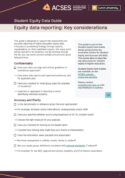This guide is designed to support the responsible and accurate reporting of higher education equity data. It focuses on presenting findings through reports, visualisations, or other published outputs. Not every point will be relevant in all situations, but by working through the list, you can avoid common pitfalls and promote good data practices.
Confidentiality
☐ Does your data use align with ethical guidelines or institutional approvals?
–> Only share data reports with approved audiences and for approved uses.
☐ Have you checked for small group sizes (for example, <5 students)?
–> Suppress or aggregate in reporting to avoid identifying individual students.
Accuracy and Clarity
☐ Is the denominator or reference group the most appropriate?
–> For example, domestic and/or international, undergraduate and/or HDR.
☐ Have you specified whether you’re using headcount or EFTSL (student load)?
–> Choose the right measure for your purpose.
☐ Have you checked for missing or incomplete data?
–> Consider how missing data might bias your results or interpretation.
☐ Does the information seem plausible and reasonable?
–> Are there unexpected or unlikely counts, trends or outliers?
☐ Are your equity group definitions consistent with national standards, if relevant?
–> For example: for low SES, regional and remote, disability, and First Nations Australians.
Timeliness and Context
☐ Is your data the most recent available?
–> If not, note the year and explain any limitations.
☐ If comparing institutions, have you considered context?
–> For example, differing student cohorts, geographic region, and courses offered.
Interpretation and Messaging
☐ Have you clearly stated the scope and limitations of your findings?
–> Avoid making sector-wide claims from local or limited data.
☐ Could your data be misinterpreted or used to make unfair comparisons?
–> Include guidance or a caveat where needed.
☐ Are you avoiding deficit framing (for example, “these students struggle”)?
–> Use strengths-based language.
Documentation
☐ Have you described how your data set was created?
–> Describe any filtering or cleaning of the data before analysis.
☐ Have you cited your data source(s) clearly?
–> For example: TCSI, QILT, institutional database.
☐ Have you included definitions or notes to explain equity group labels?
–> For example, are area-based groups defined using first or current address?
☐ Do your visuals include titles, axis labels, and a clear description?
–> Visuals should be as self-explanatory as possible.
☐ Are you respecting copyright and licensing?
–> Only reuse data, text, or visuals from other sources if you are allowed to do so, and include appropriate attribution.
Accessibility
☐ Have you reviewed your document for accessibility?
–> Accessible practices for Word, PowerPoint, and PDFs are available on the ADCET’s Creating Accessible Document Guide.
☐ Are your visuals accessible?
–> For example, include alternate text for figures summarising key trends, and use shapes and colours to differentiate groups, rather than relying on colour alone.



